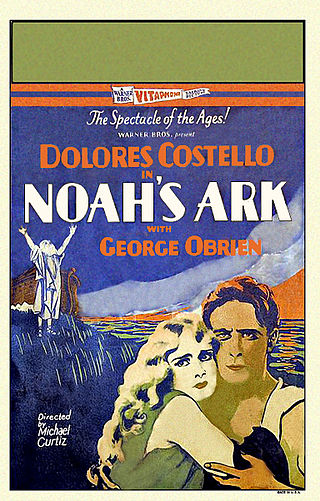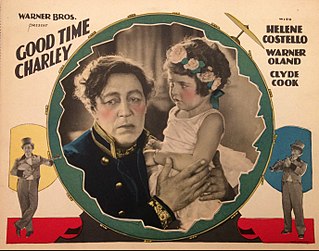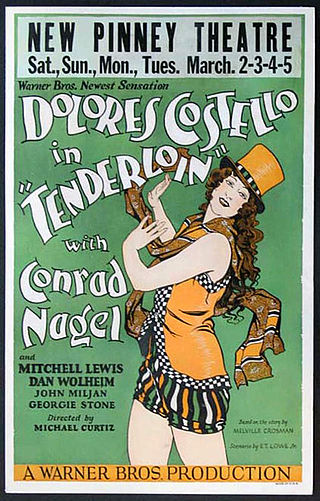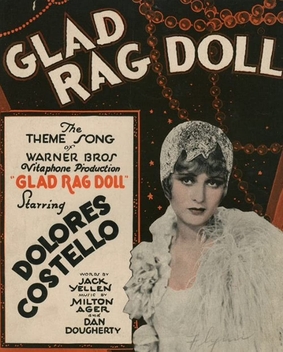
Elizabeth Patterson Bonaparte was an American socialite. She was the daughter of a Baltimore merchant and the first wife of Jérôme Bonaparte, Napoleon's youngest brother.

Don Juan is a 1926 synchronized sound American romantic adventure film directed by Alan Crosland. It is the first feature-length film to utilize the Vitaphone sound-on-disc sound system with a synchronized musical score and sound effects, though it has no spoken dialogue. The film is inspired by Lord Byron's 1821 epic poem of the same name. The screenplay was written by Bess Meredyth with intertitles by Maude Fulton and Walter Anthony.

The Show of Shows is a 1929 American pre-Code musical revue film directed by John G. Adolfi and distributed by Warner Bros. The all-talking Vitaphone production cost almost $800,000 and was shot almost entirely in Technicolor.

Noah's Ark is a 1928 American sound part-talkie epic and disaster film directed by Michael Curtiz and starring Dolores Costello and George O'Brien. In addition to sequences with audible dialogue or talking sequences, the film features a synchronized musical score and sound effects along with English intertitles. The soundtrack was recorded using the Vitaphone sound-on-disc system. The story is by Darryl F. Zanuck. The film was released by the Warner Bros. studio. Most scenes are silent with a synchronized music score and sound effects, in particular the biblical ones, while some scenes have dialogue.

General Crack is a 1929 American pre-Code sound all-talking historical costume melodrama with Technicolor sequences which was directed by Alan Crosland and produced and distributed by Warner Bros. It was filmed and premiered in 1929, and released early in 1930. It stars John Barrymore in his first full-length talking feature. The film would prove to be Crosland and Barrymore's last historical epic together. It was based on the 1928 novel General Crack by the British writer Marjorie Bowen, published under the name George Preedy, one of her several pen names.

Hearts Divided is a 1936 American musical film about the real-life marriage between American Elizabeth 'Betsy' Patterson and Jérôme Bonaparte, brother of Napoleon. It stars Marion Davies and Dick Powell as the couple. The film was a remake of the 1928 silent film Glorious Betsy, which was in turn based on the play Glorious Betsy by Rida Johnson Young. In real life, they were married in Baltimore, before sailing for Europe. Napoleon annulled the marriage, in spite of the existence of a child, and forced Jerome to marry the Princess Catharina, making him king of Westphalia. “Luckily, Hollywood treats the lovers Betsy and Jerome with a little more compassion. The couple is even granted a second chance at happiness by Claude Rains' Napoleon.”

Hollywood Pacific Theatre is a movie theater located at 6433 Hollywood Boulevard in Hollywood, Los Angeles, California, along the famous Hollywood Walk of Fame.

My Man is a 1928 black and white sound part-talkie American comedy-drama musical film directed by Archie Mayo starring Fanny Brice and featuring Guinn "Big Boy" Williams. In addition to sequences with audible dialogue or talking sequences, the film features a synchronized musical score and sound effects along with English intertitles. The soundtrack was recorded using the Vitaphone sound-on-disc system.

The Third Degree is a 1926 American silent romance film produced and distributed by Warner Bros. and directed by Michael Curtiz, in his first American film. Starring Dolores Costello, it is based on the hit 1909 play of the same name written by Charles Klein that starred Helen Ware.

Good Time Charley is a 1927 American synchronized sound drama film produced and distributed by Warner Bros. and directed by Michael Curtiz. While the film has no audible dialog, it was released with a synchronized musical score with sound effects using the Vitaphone sound-on-disc process. It was considered to be a lost film. However, as of January 2021, the film is listed as extant at the Library of Congress.

Tenderloin is a 1928 American sound part-talkie crime film directed by Michael Curtiz and starring Dolores Costello. In addition to sequences with audible dialogue or talking sequences, the film features a synchronized musical score and sound effects along with English intertitles. The soundtrack was recorded using the Vitaphone sound-on-disc system. It was produced and released by Warner Bros. Tenderloin is considered a lost film, with no prints currently known to exist.

Glad Rag Doll is a 1929 American sound part-talkie pre-Code drama film directed by Michael Curtiz and starring Dolores Costello, Ralph Graves and Audrey Ferris. In addition to sequences with audible dialogue or talking sequences, the film features a synchronized musical score and sound effects along with English intertitles. The soundtrack was recorded using the Vitaphone sound-on-disc system. This is one of many lost films of the 1920s, no prints or Vitaphone discs survive, but the trailer survives. The film's working title was Alimony Annie, but was changed match the title of the theme song. The theme song is entilted Glad Rag Doll both played and sung throughout the soundtrack.

Madonna of Avenue A is a 1929 pre-Code drama film directed by Michael Curtiz. It was produced and distributed by Warner Bros. It starred Dolores Costello in one of her first sound films. This is reportedly a lost film.

Hearts in Exile is a 1929 American pre-Code romance film produced and distributed by Warner Bros. and directed by Michael Curtiz. It was also released in a silent version with music and effects. It starred Dolores Costello in a story based on the 1904 novel by John Oxenham. An earlier 1915 film starring Clara Kimball Young was also produced, and is extant, but the 1929 version is considered to be a lost film.

Old San Francisco is a 1927 American synchronized sound historical drama film starring Dolores Costello and featuring Warner Oland. While the film has no audible dialog, it was released with a synchronized musical score with sound effects using the Vitaphone sound-on-disc process. The film, which was produced and distributed by Warner Bros., was directed by Alan Crosland.

When a Man Loves is a 1927 American synchronized sound historical drama film directed by Alan Crosland and produced and distributed by Warner Bros. While the film has no audible dialog, it was released with a synchronized musical score with sound effects using the Vitaphone sound-on-disc process. The picture stars John Barrymore and features Dolores Costello in the frequently filmed story of Abbe Prevost's 1731 novel Manon Lescaut. The lovers suffer, but the film has an optimistic ending, as they head to America. Manon dies at the end of the novel. The UK release title was His Lady.

The Midnight Taxi is a 1928 American early sound part-talkie thriller picture from Warner Bros. directed by John G. Adolfi and starring Antonio Moreno, Helen Costello, and Myrna Loy. In addition to sequences with audible dialogue or talking sequences, the film features a synchronized musical score and sound effects along with English intertitles. The soundtrack was recorded using the Vitaphone sound-on-disc system.

The Heart of Maryland (1927) is a silent film costume Vitaphone drama produced and distributed by Warner Bros. and directed by Lloyd Bacon. The film stars Dolores Costello as the title character, and features Jason Robards, Sr. It is based on David Belasco's 1895 play The Heart of Maryland performed on Broadway. The film is the last silent version of the oft-filmed Victorian story, other versions having been produced in 1915 and 1921.

The Redeeming Sin is a 1929 crime drama sound part-talkie film. In addition to sequences with audible dialogue or talking sequences, the film features a synchronized musical score and sound effects along with English intertitles. The soundtrack was recorded using the Vitaphone sound-on-disc system. It was produced and distributed by Warner Bros. and stars Dolores Costello. This film is a lost film.
Domestic Troubles is a lost 1928 American synchronized sound comedy film directed by Ray Enright and starring Clyde Cook, Louise Fazenda and Betty Blythe. While the film has no audible dialog, it was released with a synchronized musical score with sound effects using the sound-on-disc Vitaphone process. The film was produced and released by Warner Brothers.




















